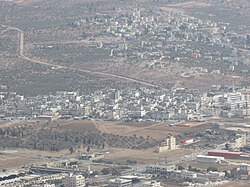Askar (Arabic: مخيم عسكر) is a Palestinian refugee camp. It is located on the outskirts of the West Bank city of Nablus and was established in 1950 on 119 dunums of land. Residents of the camp refer to this as “New Askar”.[2]
Askar Camp | |
|---|---|
| Arabic transcription(s) | |
| • Arabic | مخيم عسكر |
 Askar | |
Location of Askar Camp within Palestine | |
| Coordinates: 32°13′11.51″N 35°17′50.77″E / 32.2198639°N 35.2974361°E | |
| Country | |
| Governorate | Nablus |
| Government | |
| • Type | Refugee Camp (from 1950) |
| Area | |
| • Total | 119 dunams (0.119 km2 or 0.046 sq mi) |
| Population (2017)[1] | |
| • Total | 11,304 |
| • Density | 95,000/km2 (250,000/sq mi) |
History
Ancient period
Askar is identified with Ein Sukkar, an ancient settlement featured in the Mishnah and Talmud, as well as in the New Testament. Thanks to its fertility, the Ein Sukkar Valley is mentioned in Rabbinic literature as a place from which the grain was brought as a wave offering to the Temple when no barley was found in a place closer to Jerusalem.[3] In later years, a Samaritan settlement was established on the site; according to ancient Samaritan writings, the town was inhabited by Samaritan High Priests.[4] A Samaritan mausoleum, still in use during the fourth century CE, was found at the site.[5]
The name Askar preserves the ancient name of Ein Sukkar.[5]
Schenke believed that Askar was first settled during the early Iron Age.[6] However, Campbell dated the settlement to the Hellenistic period.[7]
Modern history
During the Second Intifada and 2002 Operation Defensive Shield, camps such as Askar were a source of considerable resistance from Palestinian militants. IDF incursions are still common in Askar refugee camp and are generally conducted for the purposes of interrogating individuals or arresting suspected militants who Israeli authorities consider to be affiliated with listed terrorist organisations.[citation needed]
The UNRWA has several installations in Askar refugee camp including schools and health clinics. In addition to these, the camp has several of its own community centers including the Center of Peace and Development located in New Askar. International volunteer work camps are run at the center annually which are hosted by the An-Najah National University.[citation needed]
According to the PCBC, the population of the camp is 11,304.[1]
References
- ^ a b Preliminary Results of the Population, Housing and Establishments Census, 2017 (PDF). Palestinian Central Bureau of Statistics (PCBS) (Report). State of Palestine. February 2018. pp. 64–82. Retrieved 24 October 2023.
- ^ "ASKAR REFUGEE CAMP". United Nations Relief and Works Agency. Retrieved 8 July 2020.
- ^ Neusner, Jacob (1999). "Menahot 10:2". The Mishnah. BRILL. ISBN 978-90-04-29411-0. OCLC 1109783020.
- ^ Conder, 1876, p. 196
- ^ a b ברקאי, רחל (1989). "סרקופגים שומרוניים מן התקופה הרומית בארץ-ישראל" [SAMARITAN SARCOPHAGI OF THE ROMAN PERIOD IN ERETZ ISRAEL]. קתדרה: לתולדות ארץ ישראל ויישובה (in Hebrew): 70.
- ^ Schenke, H.M. (1 January 2012), "Jakobsbrunnen – Josephsgrab – Sychar. Topographische Untersuchungen und Erwägungen in der Perspektive von Joh 4,5.6", Deutschen Palastina-Vereins, vol. LXXXIV, pp. 164–166, 181–184
- ^ E.F., Campbell (1991). Shechem II: Portrait of a Hill Country Vale: the Shechem Regional Survey. Scholars Press. pp. 21–23. ISBN 1-55540-642-4. OCLC 644945984.
External links
- Welcome To 'Askar R.C.
- Askar, UNWRA
- Nablus City Profile, Applied Research Institute–Jerusalem, ARIJ
- Development Priorities and Needs in Nablus, ARIJ
